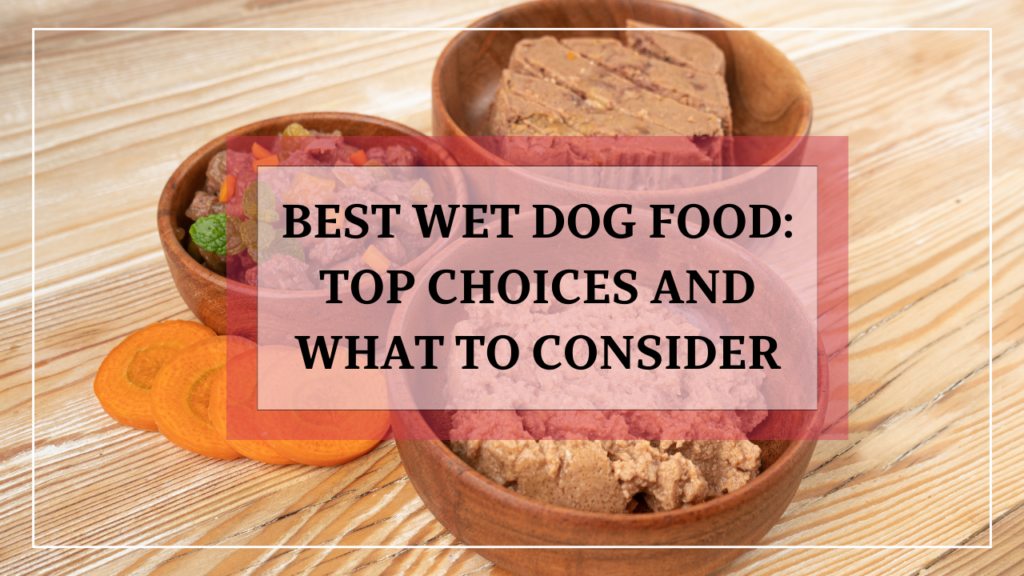What is Wet Dog Food?
Wet dog food, also known as canned dog food, is a type of dog food that comes in a moist, often gravy-like consistency. Unlike dry kibble, which is made by baking ingredients into hard pieces, wet dog food is prepared by cooking ingredients in a sealed can, which helps retain moisture. This type of dog food is highly palatable and is often used to entice picky eaters or to provide additional hydration to a dog’s diet.
Wet dog food is typically made with a variety of proteins, vegetables, and grains, all of which are cooked together and sealed in cans to preserve freshness. The moisture content in wet dog food can range from 70% to 85%, making it a more hydrating option compared to dry dog food.
Why Choose Wet Dog Food?
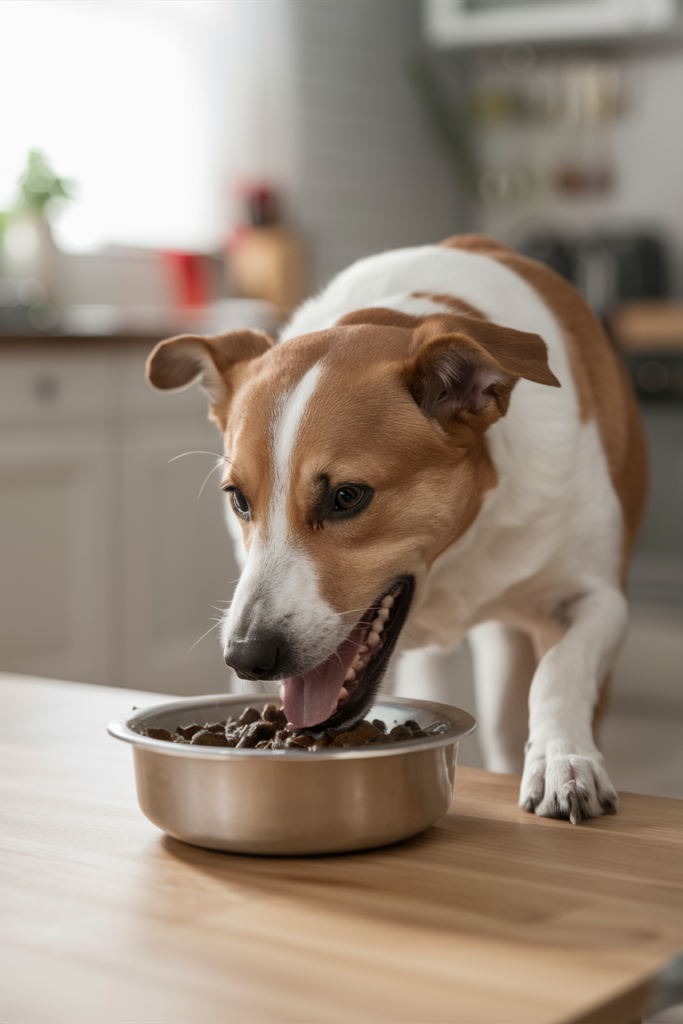
Choosing wet dog food can offer several advantages over dry dog food:
- Enhanced Palatability: Many dogs find the aroma and taste of wet dog food more appealing than dry kibble. This is especially useful for dogs who are picky eaters or have a reduced appetite due to illness or aging.
- Hydration Benefits: The high moisture content in wet dog food helps keep dogs hydrated, which is beneficial for their overall health, especially if they do not drink enough water on their own.
- Digestibility: Wet dog food is often easier to digest due to its softer texture. This can be advantageous for dogs with dental issues or digestive sensitivities.
- Variety and Flavor: Wet dog food comes in a wide range of flavors and textures, allowing you to provide a varied diet for your dog. This can help prevent boredom and ensure they receive a range of nutrients.
- Weight Management: For some dogs, wet food can be a better option for managing weight because it is typically lower in calories compared to dry food. The high moisture content helps your dog feel full without consuming too many calories.
Factors to Consider When Choosing Wet Dog Food
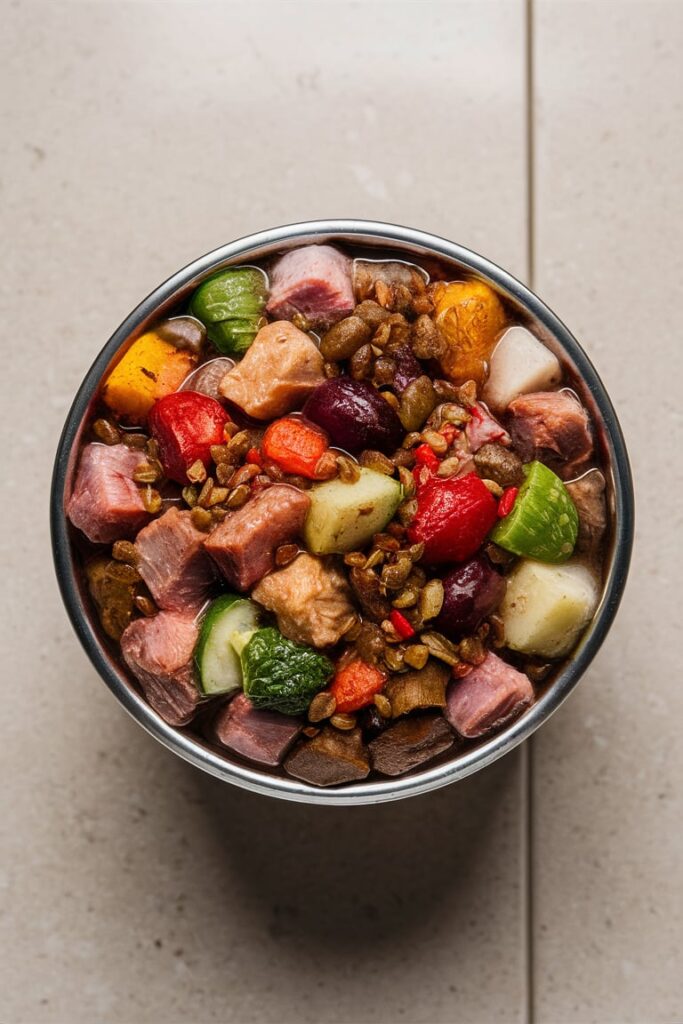
Nutritional Needs
When selecting the best wet dog food, it’s crucial to consider your dog’s specific nutritional needs. Dogs have different dietary requirements based on their age, size, activity level, and health status. Here’s a breakdown of what to look for:
- Protein Content: Dogs are primarily carnivores and need a diet rich in high-quality protein. Look for wet dog foods that list meat, poultry, or fish as the first ingredient. Protein supports muscle development, energy levels, and overall health.
- Fat Content: Fats are an essential part of a dog’s diet, providing energy and aiding in the absorption of vitamins. Ensure the wet food has a balanced fat content, typically around 5-10% for most adult dogs.
- Carbohydrates: While dogs do not require carbohydrates as much as proteins and fats, they do benefit from some carbs for energy. Whole grains, fruits, and vegetables are good sources.
- Vitamins and Minerals: Essential vitamins (A, D, E, K, and B vitamins) and minerals (calcium, phosphorus, and potassium) are necessary for various bodily functions, including bone health and immune support.
- Water Content: The high moisture content in wet dog food aids in hydration and can be particularly beneficial for dogs who don’t drink enough water.
Ingredients
The quality of ingredients is a significant factor in determining the best wet dog food. Here’s what to look for:
- High-Quality Proteins: Ingredients like chicken, beef, lamb, or fish should be listed at the top of the ingredient list. Avoid foods with vague terms like “meat by-products” or “animal digest.”
- Whole Grains and Vegetables: Look for whole grains like brown rice and vegetables such as carrots and peas. These provide essential nutrients and fiber.
- Avoid Fillers and Artificial Additives: Steer clear of foods with fillers such as corn or soy, and avoid artificial colors, flavors, or preservatives.
- Preservatives: Natural preservatives like tocopherols (vitamin E) are preferable to synthetic ones.
Special Dietary Requirements
Some dogs have specific dietary needs due to allergies, sensitivities, or health conditions. Consider the following:
- Allergies and Sensitivities: If your dog has food allergies or intolerances, choose hypoallergenic or limited-ingredient wet foods that exclude common allergens like grains or specific proteins.
- Health Conditions: For dogs with health issues like diabetes or kidney disease, look for specialized formulas that cater to their specific needs, such as low-fat or low-protein diets.
- Age-Specific Needs: Puppies, adults, and senior dogs have different nutritional requirements. Ensure the wet dog food is appropriate for your dog’s life stage.
Brand Reputation
Choosing a reputable brand is crucial for ensuring quality and safety. Look for brands with:
- Positive Reviews and Ratings: Check reviews from other pet owners to gauge the quality and effectiveness of the food.
- Veterinary Endorsements: Brands that have veterinary endorsements or are recommended by veterinarians are generally reliable.
- Transparency: Brands that provide clear information about ingredient sourcing, manufacturing processes, and nutritional content are preferable.
Best 5 Wet Dog Foods [Our Top Picks!]
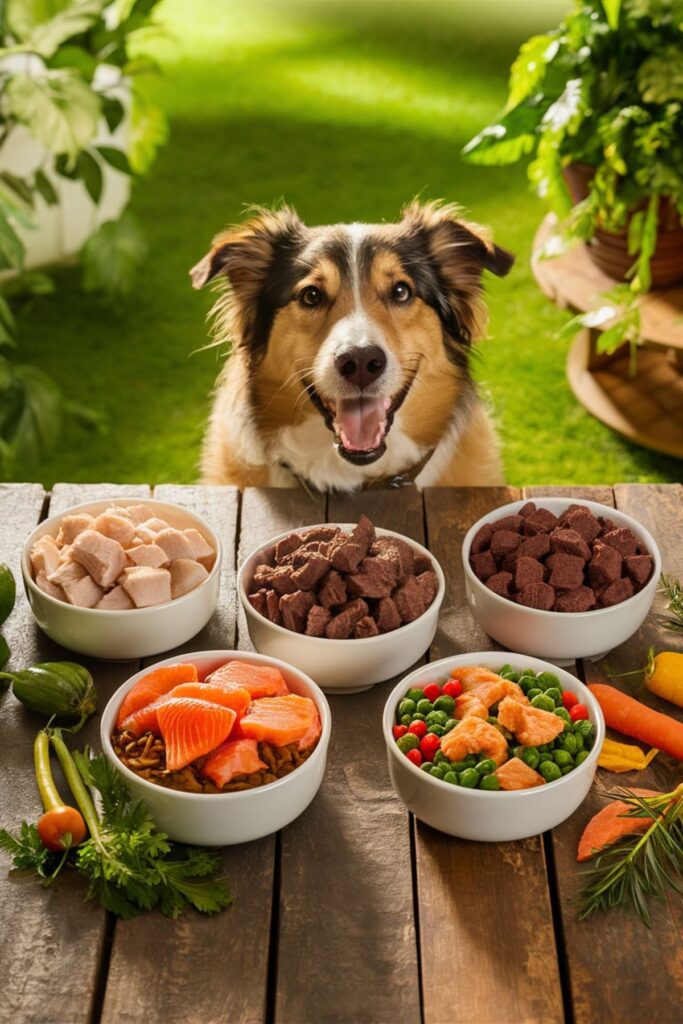
1. Royal Canin Size Health Nutrition Puppy
Overview: Royal Canin Size Health Nutrition Puppy is a well-regarded choice for growing puppies, offering tailored nutrition based on size. It’s formulated to meet the specific needs of puppies based on their breed size, whether small, medium, or large.
- Pros:
- Tailored Nutrition: Different formulas for small, medium, and large breeds.
- Digestive Health: Includes prebiotics and fiber for optimal digestion.
- Immune Support: Fortified with antioxidants to support the immune system.
- Cons:
- Cost: More expensive than many other puppy foods.
- Availability: May be harder to find in some locations.
Best For: Puppies needing breed-specific nutrition and immune support.
2. Hill’s Science Diet Puppy
Overview: Hill’s Science Diet Puppy is designed to support optimal growth and development in puppies. It contains DHA from fish oil for brain and eye development and is formulated with high-quality proteins and minerals.
- Pros:
- Brain Development: DHA supports cognitive development.
- Easy to Digest: Formulated for sensitive stomachs.
- No Artificial Additives: Free from artificial colors, flavors, and preservatives.
- Cons:
- Higher Fat Content: May not be suitable for all puppies, especially those prone to weight gain.
Best For: Puppies needing brain and eye support with easily digestible ingredients.
3. Blue Buffalo Homestyle Recipe Puppy
Overview: Blue Buffalo Homestyle Recipe Puppy is a grain-free option featuring real meat as the primary ingredient. It includes vegetables and fruits for a balanced diet.
- Pros:
- High Protein: Real meat as the first ingredient.
- Grain-Free: Suitable for puppies with grain sensitivities.
- Nutrient-Rich: Contains fruits and vegetables for added vitamins and minerals.
- Cons:
- Rich Formula: Might be too rich for some puppies’ digestive systems.
Best For: Puppies needing a high-protein, grain-free diet with added fruits and vegetables.
4. Purina Pro Plan Savor Adult
Overview: Purina Pro Plan Savor Adult is designed for adult dogs with a focus on digestive health and a healthy coat. It features high-quality chicken and live probiotics.
- Pros:
- Probiotics: Supports digestive health.
- Omega-6 Fatty Acids: Promotes healthy skin and coat.
- Palatability: Highly appealing to many dogs.
- Cons:
- Fillers: Contains some corn and other fillers that might not be ideal for all dogs.
Best For: Adult dogs needing digestive support and a healthy coat.
5. Merrick Grain-Free Texas Beef & Sweet Potato
Overview: Merrick Grain-Free Texas Beef & Sweet Potato is a high-protein, grain-free wet dog food with beef as the main ingredient. It’s designed to support overall health with a focus on protein content.
- Pros:
- High Protein: Beef is the first ingredient.
- Grain-Free: Suitable for dogs with grain sensitivities.
- No Artificial Preservatives: Free from artificial additives.
- Cons:
- Price: Generally more expensive than some other options.
Best For: Dogs needing a high-protein, grain-free diet with quality ingredients.
Top Wet Dog Food Brands For Different Needs
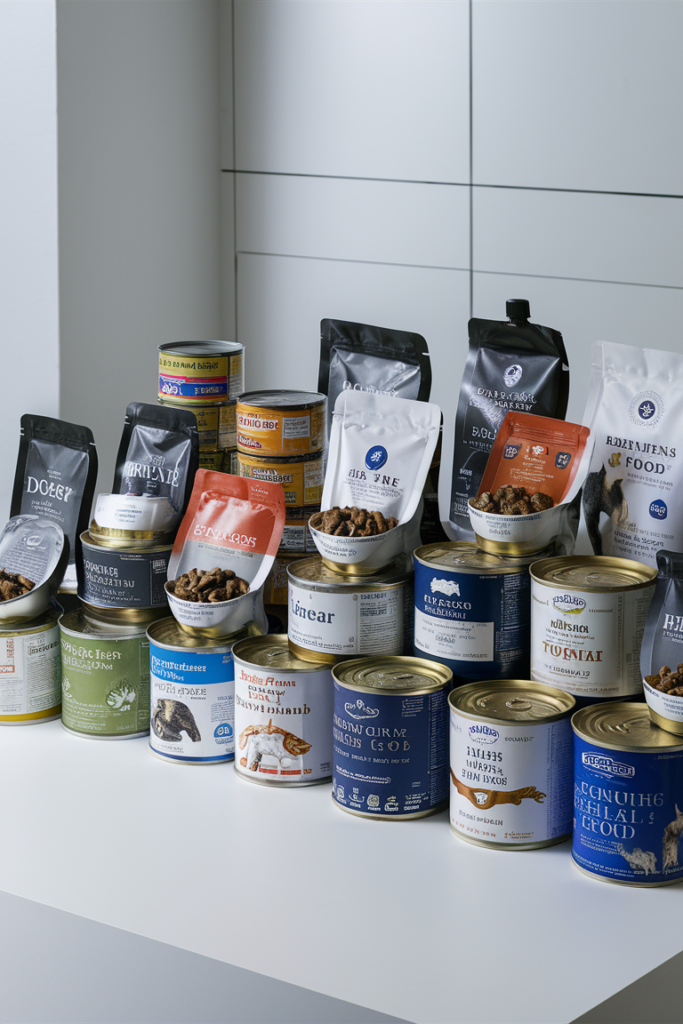
Best Wet Dog Food for Puppies
Puppies experience rapid growth and development, making their nutritional needs distinct from adult dogs. The best wet dog food for puppies provides a balanced combination of high-quality proteins, essential fats, and a precise blend of vitamins and minerals to support their health and development. Here’s a closer look at some top-rated wet dog food options:
1. Royal Canin Size Health Nutrition Puppy
Features:
- Tailored for Size: This formula is designed to meet the unique needs of puppies based on their size (small, medium, or large breed).
- High-Quality Proteins: Provides premium proteins to support muscle development and overall growth.
- Balanced Formula: Includes a carefully balanced mix of nutrients to promote healthy development and immune function.
Pros:
- Supports Immune System Development: The specific blend of nutrients helps strengthen the puppy’s immune system.
- Highly Palatable: Many puppies find this food very appealing, which can be helpful for picky eaters.
Cons:
- Higher Price Point: This brand tends to be more expensive compared to some other options, which might be a consideration for budget-conscious pet owners.
Additional Details: Royal Canin’s formulations are developed with veterinary expertise, ensuring they meet the specific needs of different breed sizes. The food’s high digestibility helps maximize nutrient absorption.
2. Hill’s Science Diet Puppy
Features:
- DHA from Fish Oil: Contains DHA, an essential fatty acid derived from fish oil, which supports brain and eye development.
- Easy to Digest: The food is designed to be easily digestible, which is important for puppies with sensitive stomachs.
- No Artificial Additives: Free from artificial colors, flavors, and preservatives.
Pros:
- Promotes Brain and Eye Health: DHA is crucial for cognitive function and visual development.
- Gentle on the Stomach: The formula is designed to be gentle on young digestive systems.
Cons:
- Higher Fat Content: Some puppies may not require or tolerate the higher fat content in this formula.
Additional Details: Hill’s Science Diet is backed by extensive research and is often recommended by veterinarians for its balanced nutrition and digestibility.
3. Blue Buffalo Homestyle Recipe Puppy
Features:
- Real Meat First Ingredient: Uses real meat (chicken, lamb, or beef) as the primary ingredient, ensuring high protein content.
- Added Fruits and Vegetables: Includes wholesome fruits and vegetables for added nutrients and antioxidants.
- Grain-Free Option: Ideal for puppies with grain sensitivities or allergies.
Pros:
- High in Protein: Supports healthy muscle development and growth with its high protein content.
- Grain-Free: Suitable for puppies with sensitivities to grains or those on a grain-free diet.
Cons:
- Rich Formula: Some puppies might find the formula too rich, leading to digestive issues for sensitive stomachs.
Additional Details: Blue Buffalo emphasizes the use of natural ingredients and avoids by-products, making it a good choice for pet owners seeking high-quality, natural food options.
Best Wet Dog Food for Adult Dogs
Adult dogs require a diet that provides all the essential nutrients to support their health, vitality, and longevity. Wet dog food can be an excellent choice for adult dogs due to its higher moisture content, which aids in hydration and can be easier for some dogs to chew and digest. When selecting the best wet dog food, it’s important to consider the nutritional profile, ingredients, and any special dietary needs your dog may have. Here are some top recommendations:
1. Purina Pro Plan Savor Adult
- Features: This wet dog food lists high-quality chicken as the primary ingredient, ensuring that your dog receives a high level of protein. It is also fortified with live probiotics, which are beneficial for digestive health.
- Pros:
- Digestive Health: The inclusion of live probiotics helps maintain a healthy digestive system and can prevent gastrointestinal issues.
- Skin and Coat Health: Omega-6 fatty acids and vitamin A promote a healthy skin and shiny coat, contributing to your dog’s overall well-being.
- Cons:
- Fillers: Some versions of this food may contain fillers like corn, which can be less ideal for dogs with sensitivities or allergies. Fillers may also provide fewer nutrients compared to higher-quality ingredients.
2. Nutro Ultra Grain-Free
- Features: Nutro Ultra combines three high-quality animal proteins (chicken, lamb, and salmon) and non-GMO vegetables. This formula provides a balanced mix of protein, fats, and fiber.
- Pros:
- Nutrient-Rich: The blend of proteins and antioxidants from fruits and vegetables supports overall health, including immune function and energy levels.
- Grain-Free: The absence of grains makes it suitable for dogs with grain sensitivities or allergies.
- Cons:
- Flavor Options: Nutro Ultra offers a more limited variety of flavors compared to other brands, which may not suit every dog’s taste preferences.
Best Wet Dog Food for Seniors
Senior dogs have unique dietary needs that address their aging bodies. When selecting wet dog food, consider options that support joint health, maintain a healthy weight, and are easier to digest. Here are some top choices:
1. Hill’s Science Diet Senior
- Features: Formulated with easy-to-digest ingredients and omega-6 fatty acids. It also includes antioxidants for overall health.
- Pros:
- Supports joint health and mobility with added glucosamine and chondroitin.
- Promotes a healthy coat with omega-6 fatty acids.
- Designed to be gentle on an aging digestive system.
- Cons:
- Contains some artificial ingredients and preservatives, which may not be ideal for all pet owners.
2. Blue Buffalo Homestyle Recipe Senior
- Features: Includes deboned chicken and whole grains, plus glucosamine and chondroitin for joint health.
- Pros:
- Supports overall senior health with high-quality, natural ingredients.
- No by-products, corn, wheat, or soy, which is good for dogs with food sensitivities.
- Glucosamine and chondroitin aid in joint function and mobility.
- Cons:
- Grain-based formula might not be suitable for dogs with grain allergies or those on a grain-free diet.
3. Wellness CORE Grain-Free Senior
- Features: High-protein formula with glucosamine and taurine. Grain-free to reduce the risk of allergies.
- Pros:
- Supports lean muscle mass and joint health with high protein and glucosamine.
- Grain-free, making it suitable for dogs with grain sensitivities.
- Cons:
- Higher fat content may not be ideal for dogs prone to obesity or those with specific dietary restrictions.
Additional Considerations
- Nutrient Balance: Look for foods rich in vitamins and minerals that support cognitive function and overall vitality. Ingredients like antioxidants, omega fatty acids, and joint-supporting supplements are beneficial.
- Digestibility: Choose wet foods with easily digestible ingredients to prevent gastrointestinal issues and ensure nutrient absorption.
- Weight Management: Opt for foods with controlled fat levels and high protein content to help maintain a healthy weight and support lean muscle mass.
Always consult with your veterinarian to tailor your senior dog’s diet to their specific health needs and conditions.
Best Wet Dog Food for Dogs with Allergies
When selecting wet dog food for dogs with allergies, it’s essential to focus on recipes that reduce potential allergens while maintaining nutritional balance. Many dogs have sensitivities to common ingredients like grains, certain proteins, or artificial additives. Identifying and choosing wet food that avoids these triggers can significantly improve your dog’s well-being.
Blue Buffalo Basics Limited Ingredient Diet
Features: This formula contains a limited number of ingredients, which reduces the likelihood of triggering food sensitivities. With a single animal protein source (e.g., turkey or salmon) and no grains or artificial additives, it’s designed for easy digestion and allergy control.
Pros:
- Grain-free formula reduces exposure to common allergens like wheat and corn.
- Single protein source simplifies the ingredient list, making it easier to identify triggers.
- Supports a healthy immune system with added vitamins and minerals.
Cons:
- Limited protein options mean some dogs may not find a suitable flavor or protein source.
- Higher price point compared to conventional wet dog food.
Ideal For: Dogs with mild to moderate food sensitivities, especially those reacting to grains or multiple ingredients.
Best Wet Dog Food for Weight Management
Maintaining a healthy weight is key to avoiding obesity-related problems such as joint issues, diabetes, and heart disease. Wet dog foods formulated for weight management balance calories and nutrients while ensuring your dog feels full and satisfied.
1. Hill’s Science Diet Light Adult
Features: With lower calories and fat, this wet food is crafted to help overweight dogs shed pounds without losing muscle mass. It includes high-quality protein to maintain lean muscle while supporting fat metabolism.
Pros:
- Effective for dogs that need to lose weight while still receiving balanced nutrition.
- Contains clinically proven antioxidants that support a healthy immune system.
- Helps maintain lean muscle mass through its high protein content.
Cons:
- Some dogs may find the taste less appealing compared to more calorie-dense wet foods.
- Premium pricing compared to non-specialized foods.
Ideal For: Overweight dogs that need to manage or reduce their weight, particularly those with underlying health conditions that require careful calorie management.
2. Purina Pro Plan Focus Weight Management
Features: This wet food provides lower fat content with added fiber to help control appetite and maintain a healthy weight. It also includes omega fatty acids for skin and coat health, making it a comprehensive option for weight and overall health management.
Pros:
- Helps dogs feel fuller longer thanks to its fiber content, reducing overeating.
- Contains omega fatty acids, which support a healthy coat and skin.
- Specifically formulated to promote healthy weight loss without sacrificing nutrients.
Cons:
- Includes fillers like corn, which may not suit all dogs, particularly those with grain sensitivities.
- Could be too low in calories for highly active dogs.
Ideal For: Dogs prone to obesity but without grain sensitivities, or those needing to control portion sizes more easily due to overeating tendencies.
3. Wellness CORE Grain-Free Reduced Fat
Features: With high protein and reduced fat content, this grain-free formula supports lean muscle mass while helping to reduce overall body fat. It also contains high-quality ingredients with no artificial additives, grains, or fillers, making it a premium choice for weight management.
Pros:
- Grain-free and rich in high-quality proteins, making it ideal for dogs with grain sensitivities.
- Helps dogs feel full without over-consuming, promoting gradual weight loss.
- Supports muscle maintenance, essential for active dogs.
Cons:
- Higher price point may not fit all budgets.
- The absence of grains may not be necessary for dogs that tolerate them well.
Ideal For: Dogs that need to lose weight while maintaining muscle, particularly those with grain sensitivities or more active lifestyles.
Comparing Wet Dog Food to Other Types of Dog Food
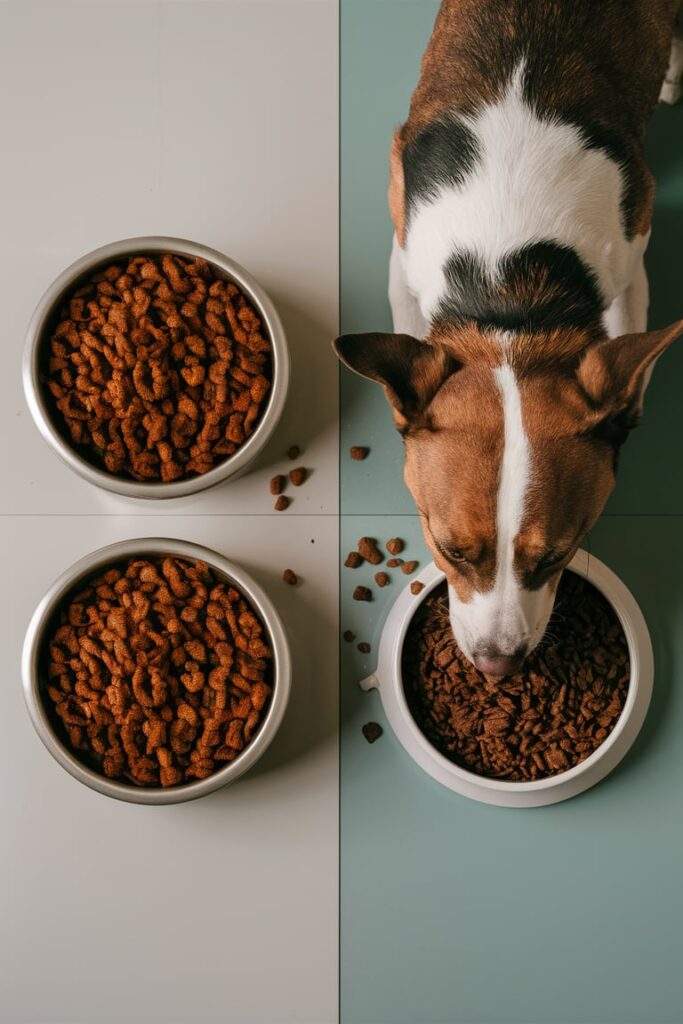
Wet Dog Food vs. Dry Dog Food
When choosing between wet and dry dog food, there are several factors to consider. Each type has its own benefits and drawbacks:
Wet Dog Food:
- Pros:
- Higher Moisture Content: Helps keep dogs hydrated, which can be beneficial for their urinary tract and overall health.
- Enhanced Palatability: Often more appealing to dogs due to its aroma and texture.
- Easier to Digest: Softer texture is easier on dogs with dental issues or digestive sensitivities.
- Variety: Available in a wide range of flavors and formulations.
- Cons:
- Cost: Generally more expensive than dry food.
- Shelf Life: Requires refrigeration after opening and has a shorter shelf life compared to dry food.
- Dental Health: Less effective at helping to clean teeth compared to dry kibble.
Dry Dog Food:
- Pros:
- Cost-Effective: Typically less expensive than wet food.
- Convenient: Easy to store, has a longer shelf life, and does not require refrigeration.
- Dental Health: Crunchy texture can help reduce plaque and tartar buildup.
- Variety of Formulations: Available in many formulas tailored to different needs and life stages.
- Cons:
- Lower Moisture Content: Does not contribute to hydration.
- Less Palatable: May be less appealing to some dogs compared to wet food.
- Digestibility: May be harder for some dogs to digest, especially those with sensitive stomachs.
Wet Dog Food vs. Raw Dog Food
Raw dog food, often referred to as a raw or “BARF” diet (biologically appropriate raw food), differs significantly from wet and dry kibble. Here’s a comparison:
Wet Dog Food:
- Pros:
- Convenience: Ready-to-serve and does not require preparation.
- Consistency: Consistent quality and nutritional balance.
- Hydration: High moisture content supports hydration.
- Cons:
- Processing: May be more processed compared to raw diets.
- Additives: Can contain preservatives and additives.
Raw Dog Food:
- Pros:
- Natural Ingredients: Typically made from fresh, whole foods.
- Nutrient-Rich: High in protein and free from fillers and artificial ingredients.
- Digestibility: Some believe it improves digestion and coat quality.
- Cons:
- Preparation and Storage: Requires careful handling and preparation to avoid contamination.
- Cost: Generally more expensive and may require sourcing from specialty suppliers.
- Nutritional Balance: Must be carefully balanced to avoid deficiencies or excesses.
How to Transition Your Dog to a New Wet Dog Food
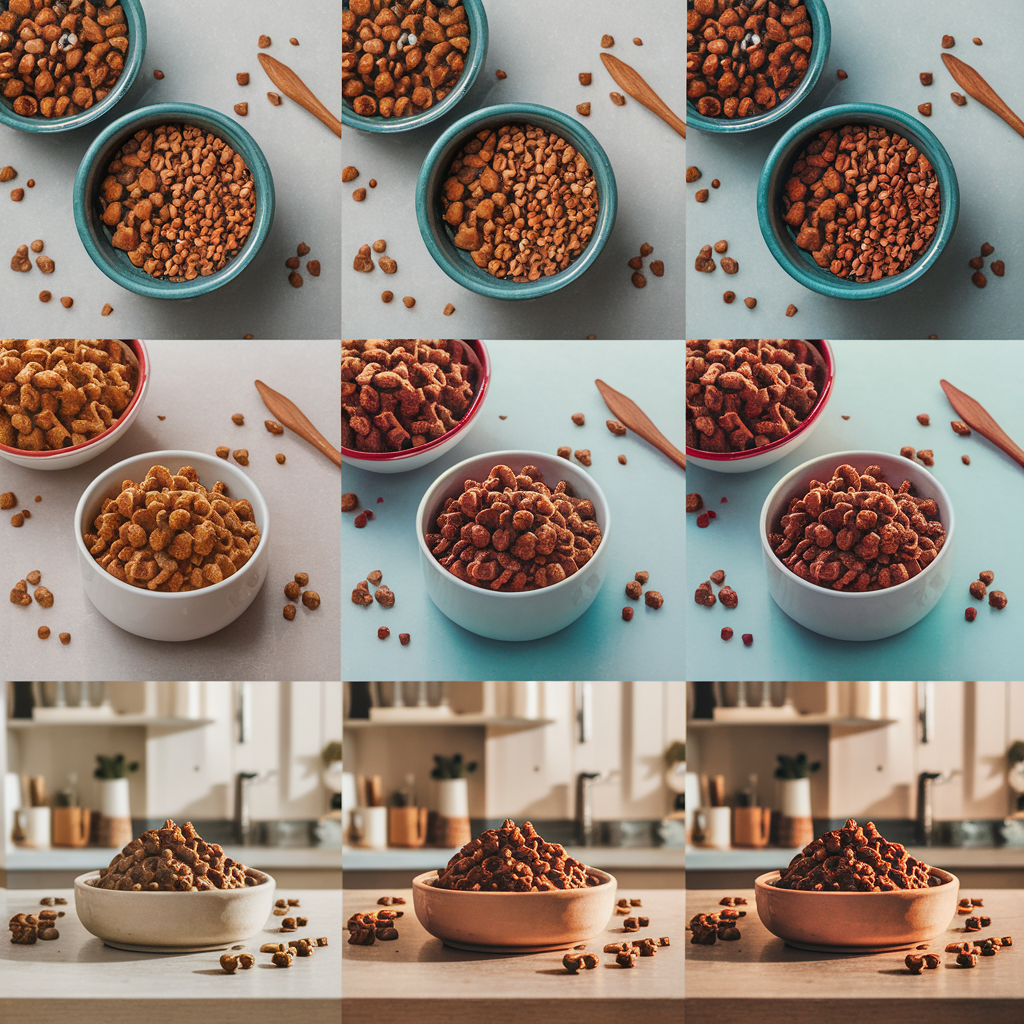
Understanding the Importance of Gradual Transitions
Transitioning your dog to a new wet dog food should be done gradually to avoid digestive upset. Abrupt changes in diet can lead to gastrointestinal issues such as diarrhea, vomiting, or a loss of appetite. A gradual transition helps your dog adjust to the new food and allows their digestive system to adapt.
Step-by-Step Guide to Transitioning
1. Start with a Mix: Begin by mixing a small amount of the new wet dog food with your dog’s current food. Use a ratio of about 25% new food to 75% old food. This helps your dog become accustomed to the new flavor and texture.
2. Increase the New Food Gradually: Over the next several days, gradually increase the proportion of the new food while decreasing the amount of the old food. You can follow this general schedule:
- Days 1-2: 25% new food, 75% old food.
- Days 3-4: 50% new food, 50% old food.
- Days 5-6: 75% new food, 25% old food.
- Day 7: 100% new food.
3. Monitor Your Dog’s Reaction: Watch for any signs of digestive upset, such as changes in stool consistency, vomiting, or loss of appetite. If you notice any issues, slow down the transition process or consult your veterinarian.
4. Maintain Consistency: Once your dog is fully transitioned to the new wet food, stick to the new diet to avoid further disruptions. Consistency is key to ensuring your dog’s digestive health and overall well-being.
Tips for a Smooth Transition
- Choose a Similar Food: Select a new wet dog food that has similar ingredients to the old food to minimize digestive changes.
- Check for Allergies: If your dog has known food allergies, ensure the new food does not contain allergens.
- Consult Your Veterinarian: If you have any concerns about the new food or your dog’s health, seek advice from your veterinarian.
How to Store and Serve Wet Dog Food
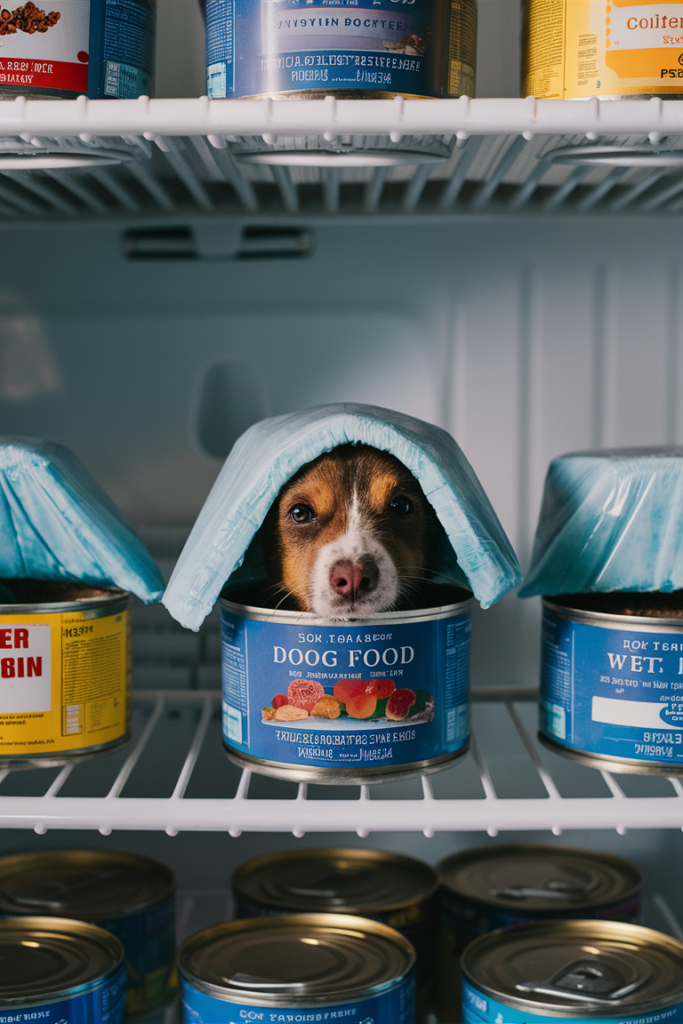
Proper Storage Techniques
Proper storage of wet dog food is essential to maintaining its freshness and nutritional quality. Here are some tips to ensure your dog’s food stays safe and palatable:
**1. Unopened Cans: Store unopened cans of wet dog food in a cool, dry place away from direct sunlight and heat. Most wet dog foods have a shelf life of 1-3 years from the date of manufacture, but always check the expiration date on the can.
**2. Opened Cans: Once opened, wet dog food should be covered and refrigerated. Use a can cover or wrap the can with plastic wrap to keep the food fresh. Most opened cans should be used within 3-5 days.
**3. Avoid Contamination: Use clean utensils when serving wet dog food to prevent contamination. Never use your hands or dirty utensils, as this can introduce bacteria into the food.
**4. Check for Spoilage: Always inspect wet dog food for signs of spoilage, such as an off smell, discoloration, or mold. If the food appears spoiled, discard it immediately.
Serving Wet Dog Food
**1. Portion Control: Follow the feeding guidelines on the dog food label to determine the appropriate serving size for your dog’s size, age, and activity level. Overfeeding can lead to obesity, while underfeeding can result in nutritional deficiencies.
**2. Mixing with Dry Food: Many pet owners choose to mix wet dog food with dry kibble to provide a variety of textures and flavors. If you do this, adjust the portion sizes of both the wet and dry food to avoid overfeeding.
**3. Serving Temperature: Wet dog food can be served at room temperature or slightly warmed. Warming the food can enhance its aroma and make it more appealing to your dog. Avoid serving it hot, as it may cause discomfort.
**4. Regular Feeding Schedule: Establish a regular feeding schedule to help regulate your dog’s appetite and digestion. Consistent meal times can also help in maintaining a healthy weight.
Common Questions About Wet Dog Food
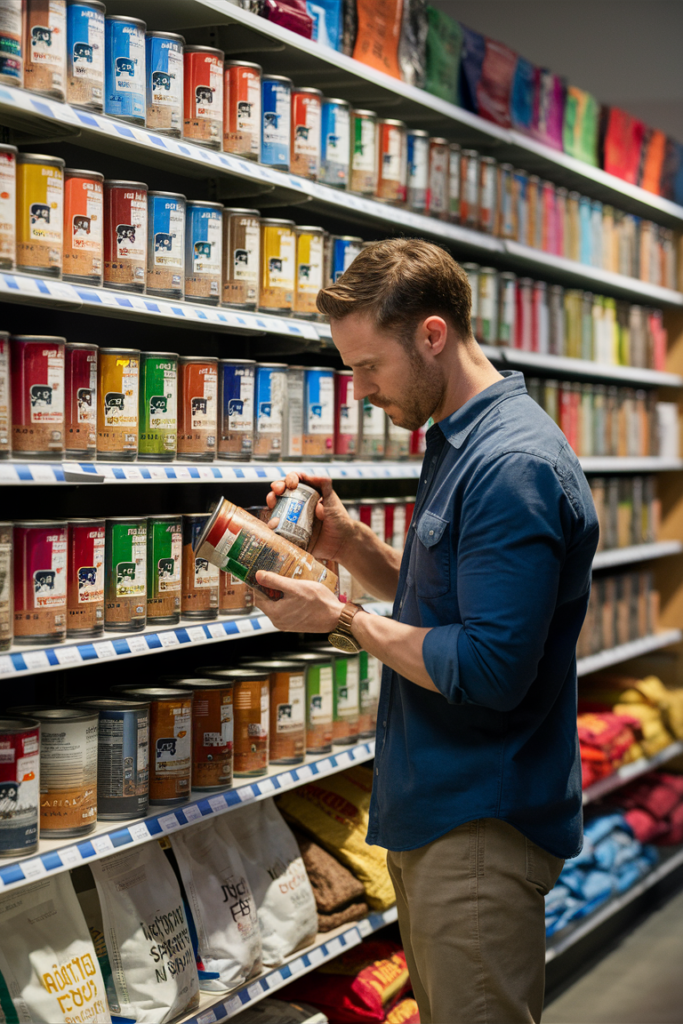
Is Wet Dog Food Better Than Dry Dog Food?
Wet dog food and dry dog food both have their advantages and disadvantages, and the best choice depends on your dog’s specific needs.
- Benefits of Wet Dog Food:
- Hydration: High moisture content helps with hydration and can be beneficial for dogs with urinary issues.
- Palatability: Often more appealing to picky eaters due to its aroma and texture.
- Ease of Digestion: Softer texture is easier to chew and digest, especially for dogs with dental issues.
- Benefits of Dry Dog Food:
- Cost-Effective: Generally more affordable and provides a balanced diet.
- Convenience: Longer shelf life and easier to store and serve.
- Dental Health: Crunchy kibble helps reduce plaque and tartar buildup.
Ultimately, the best choice depends on your dog’s health, preferences, and dietary needs. Some pet owners choose to use a combination of wet and dry food to take advantage of the benefits of both types.
How Can I Tell if Wet Dog Food is Fresh?
To ensure wet dog food is fresh and safe for your dog, look for the following indicators:
- Check the Expiration Date: Always check the expiration date on the can before purchasing and before serving it to your dog.
- Inspect the Food: Look for any changes in color, texture, or odor. Spoiled wet dog food may have a sour smell or unusual texture.
- Look for Mold: Any signs of mold or an off-smell indicate that the food has gone bad and should be discarded.
Can Wet Dog Food Be Used for Dogs with Allergies?
Yes, wet dog food can be suitable for dogs with allergies, but it’s essential to choose a product specifically formulated to address their needs:
- Limited Ingredient Diets: These diets contain fewer ingredients and are designed to minimize allergens. They typically have a single protein source and no grains or artificial additives.
- Hypoallergenic Formulas: These foods use hydrolyzed proteins that are less likely to trigger allergic reactions.
Always check the ingredient list and consult with your veterinarian to ensure the food is appropriate for your dog’s specific allergies.
How Often Should I Feed My Dog Wet Dog Food?
The frequency of feeding depends on your dog’s age, size, activity level, and overall health. Generally:
- Puppies: Require more frequent feedings, typically 3-4 times a day, due to their rapid growth and high energy needs.
- Adult Dogs: Usually do well with two meals a day.
- Senior Dogs: May benefit from smaller, more frequent meals depending on their health condition.
Refer to the feeding guidelines on the wet dog food packaging for specific recommendations based on your dog’s size and life stage.
What Should I Do If My Dog Doesn’t Like the New Wet Food?
If your dog is reluctant to try a new wet dog food:
- Introduce Gradually: Mix a small amount of the new food with their current food and gradually increase the proportion over several days.
- Enhance Palatability: Try warming the food slightly or adding a small amount of a favorite treat or topper.
- Consult Your Veterinarian: If your dog continues to refuse the food, consult with your vet to ensure there are no underlying health issues and to explore other suitable options.

Hi, I’m Ali Tarek, the founder of Animalsman. I’ve always been passionate about pets, especially dogs and cats, and I created this website to share practical tips, easy recipes, and helpful care advice for fellow pet lovers. My goal is to make pet care simple, enjoyable, and accessible for everyone. When I’m not writing or curating content, you’ll usually find me spending time with my furry friends or learning new ways to keep them happy and healthy.

